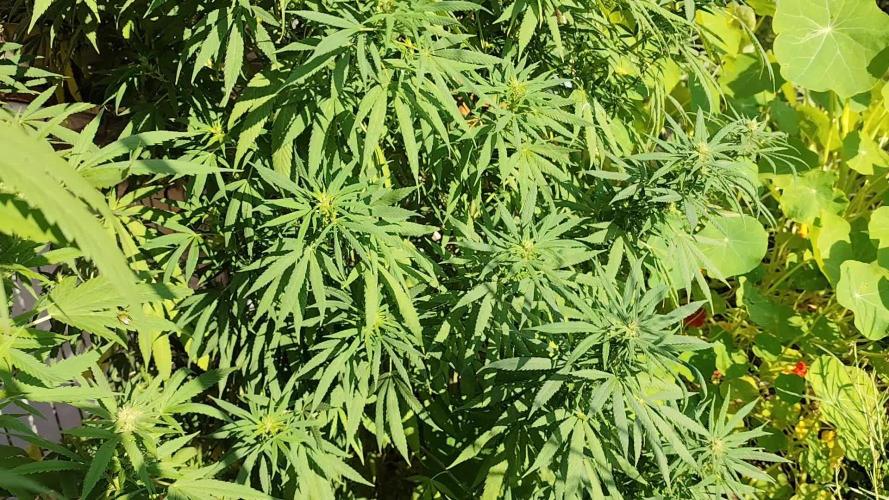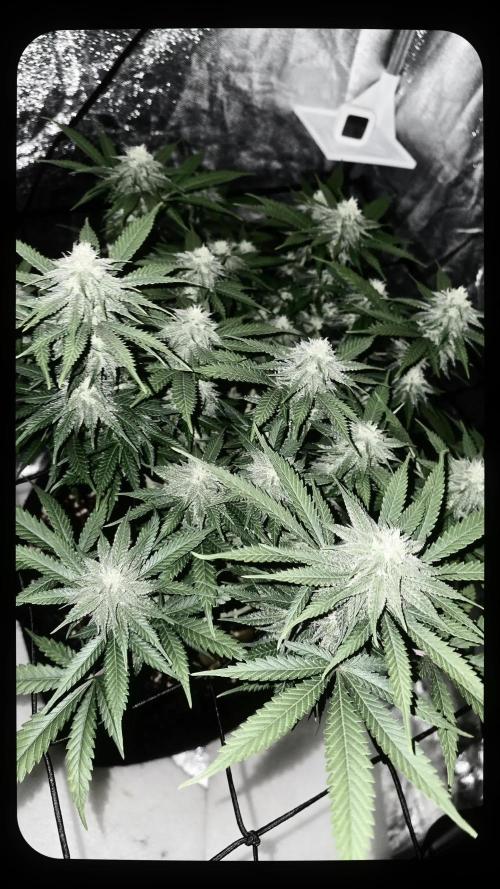The Grow Awards 2026 🏆 





























Processing
Likes
Comments
Share


@budlicious
Follow
This week has been good, pistils started showing up on the 27th. Just watering with ph'd dechlorinated tap water. I bought lst wire but I'm not too sure if I did lst the best way but there are about 6 side branches with tops and 5 more on the way. Im probably going to be switching my 50% veg 20% bloom, to a 50/50 consuming 190 true watts from the wall next week.
Likes
36
Share


@Growbody
Follow
Hallo und herzlich willkommen zu meinem Growbericht Outdoor 2025 mit den Sorten Power Flower Feminized, Royal Medic Feminized und Special Kush #1 Feminized, alle 3 von Royal Queen Seeds. Es ist das erste Mal, das ich Töpfe für den Outdoor grow verwende, bisher waren alle Gorilla grows und direkt in die Erde gepflanzt.
Die URL der Power Flower Feminized: https://www.royalqueenseeds.de/feminisierte-hanfsamen/120-power-flower.html
Die URL der Royal Medic Feminized: https://www.royalqueenseeds.de/cbd-samen/148-royal-medic.html
Die URL der Special Kush #1 Feminized: https://www.royalqueenseeds.de/feminisierte-hanfsamen/138-special-kush-1.html
Die Planung für den Grow ist, die Samen in easyplug Anzuchtwürfeln keimen zu lassen und danach in 0,6L und 2,2L Plastiktöpfen, dann letztlich in die neuen komplett doppellagigen ROOTIES 15 Liter Wide Version Stofftöpfe umzutopfen. Sobald die Witterung es zuläßt, sollen die Pflanzen an die frische Luft.
Es ist schon eine Weile her, das der Grow losging, die Bilder sind jetzt aktuell.
Tag 205: Endlich wieder Sonne, wenn auch mit vielen Wolken. Die letzte Woche hatte nach den 40 L/m² am Wochenende weitere 23 L/m² Regen gebracht. Die drei Ladies haben die ganze Woche unter'm Balkon gestanden, jetzt können sie wieder Sonne tanken. Sie duften sehr fein.
Tag 206: Hab das schöne Wetter genutzt und die drei Großen etwas entlaubt. Es waren jeweils eine große Handvoll Laub, man sieht es aber kaum. Bei der Menge an Laub werd ich das noch ein paarmal machen. Das Große Heupferd darf im Canabis nach Beute jagen.
Tag 207: Die drei Feinen waren heute morgen ziemlich nass, hab nochmal ordentlich entlaubt, das mehr Licht und Luft reinkommt.
Tag 208: Hab mal Fotos der drei Bäume um die Mittagszeit gemacht. Man kann gut sehen, wie nass die Blätter da noch sind. Werde also nicht bis November warten.
Wenn's dir gefallen hat, schau wieder vorbei ✌️😎
Likes
Comments
Share


@Dirizhor
Follow
Hi, exciting times, flowering, see some stratching, but not too much.
Plant now drinks 2 liters a time, each 2 days. Befor I was giving 1 liter every 3 days. So water cosumption encreased more then 3 times.
Smell is not strong yet, as expected.
Not much really I need to do escept mixing fertilizer and water the plant.
Likes
109
Share


@PapaNugs
Follow
This strain is awesome. Had good germination rates. Trained well and filled out. Produced some amazing smelling buds. Was only ruined because another strain in the tent hermed. Otherwise it would have been perfect. So frost. Trichomes growing all over the place. Will be growing this strain in the future and still one of my favorites dispite the failure.
Likes
7
Share


@Lifesgarden420
Follow
This lady is getting better every week
All of her sisters are too
Amazing genetics with amazing nutrients
I hit flower by mistake cuz she's still in veg
Likes
15
Share


@vibealive
Follow
Just started this one off... Not much to say so far.
This is a coco grow. I started off with an amended Coco using Gaia Green 4-4-4 and power bloom 2-8-4.
Likes
6
Share


@Takeaims
Follow
Still going strong a few weeks apart for some of these ladies going to topp the ones in weeks 3
Likes
19
Share


@Dunk_Junk
Follow
I cannot believe how bushy she is! Very very short internode length. I'm wondering if I have an indica dominant plant? 😭
But anyway, she is doing her thing this week. She only grew 9cm this week. Nutrients this time are 20-20-20 NPK powdered fertiliser I'm trying this time around. About 1.2 grams mixed with 10L of water makes ~1000ppm. My clean water alone is ~350ppm of that.
I do have a CO2 bag generator thing... It's not doing a lot though. My CO2 meter reads barely over 400ppm.........
Likes
14
Share


@Biggy2k20
Follow
This week has proven to be a good week with signs of this plant exploding with size. Flushing has began as nutrients were reduced. I am looking forward over the next 2 weeks
Likes
2
Share


@Drtomb
Follow
I have one week left on a straight eater flush. These girls are ready for dec 24th harvest date.
I did notice a couple bananas on this genetic, so ill be getting rid of the mom after this go.
This is why i test all mothers.
Likes
27
Share


@DankeyeBeaverjuice
Follow
Really boring week, nothing changed, nothing exciting happened, just food and water. There's some really nice purples coming through the flower right now and I can make out the tell tale signs of the cookies on both phenos, they may not look the same but the smell coming of both plants is identical..
Likes
53
Share


@BudBoutique
Follow
! this is my current status, gonna upload my last veg weeks within the next week - got a bit busy around Spannabis - thank you for your understanding! 💚
Welcome to Bud Boutique Grow Diary - really appreciate all your love and support :)
Dont forget to check out my other current grows!
🗓️ This Week:
after 48 hours of complete darkness (important for seedlings to make sure all plants switch into flower same time), I finally switched my lights to the 12/12 schedule and sent my ladies into the flower.
- both Phenos super strong and praying up,
- more than healthy and going well, just one of them needs a little more water and attention than the other ;)
- Day 3: Foliar spray with APTUS Regulator and APTUS Nutrispray to give them extra micronutrients and give them a little shell for protection.
! always use APTUS Regulator first and mix well with your water before adding any other nutrients for Feeding or Foliar!
Thank you for still staying with me 💚
___________________________________________
--- 🌱 Strain (Sponsor) ---
🏷️ P.C.R. by Art Genetix
https://www.artgenetix.world/product-page/p-c-r
--- 🥗 Nutrients and Feeding (sponsored by APTUS: APTUS Ambassador) ---
🍸 APTUS: full nutrient schedule extreme
-- Regulator, N-Boost, P-Boost, CaMg-Boost, K-Boost, Allin1 Liquid, Startbooster, Topbooster, Enzym+ every feeding
-- Fulvic-Blast, NutriSpray as Foliar each once a week
🔗 https://aptus-holland.com/
--- ♻️ Grow Control (Sponsor) ---
TROLMASTER: TENT-X + LM14 Light Adapter to dim/sunrise/sunset lights + Temp & rH Sensor all remote on App
🔗 https://www.trolmaster.eu/
--- 🏭 Grow Setup ---
💡LUMATEK Zeus Pro 600
* 🏠🌿 Indoor: Homebox 120x120x200cm (4x4)
* 📐🌀 PrimaKlima exhausting Fan 1180m3/h (running on 60-80%)
* 🌀 Can Light Filter 800m3/h & 1x Fanbox 1x Dyson fan for Air circulation
🔗 https://lumatek-lighting.com/zeus-600w-pro-29/
🔗 https://primaklima.com/de/shop/ventilatoren-de/ec-ventilatoren/pk160ec-tc/
🔗 https://canfilters.com/products/filters/
All Likes and comments are highly appreciated!!!
👨🌾 don't forget to check out my Instagram for daily educational content: budboutiquee
- Bud Boutique
Likes
4
Share


@aliengrowETK
Follow
Poderia ter saído melhor mais foi muito boa a experiência !! Valeu✌️🏼👽600
Likes
18
Share


@Stonyways
Follow
lights up to 66w, 28 inches from the top of the plants, fox farm nutrients for this grow..... already anticipating my next grow...
start to the the Peet Pods I used were/are garbage, first and last time I will use them
Likes
22
Share


@Smith420
Follow
It’s really difficult trying to figure out the watering at this point. Besides that and the lighting everything else seems to be easier to control due to the technology. The human nature aspect and learning about my medicine and how the plants start to develop more growth and require different needs and attention in each stage is fascinating. It’s my first time and trying to mash up all the information I read online. Well anyways to everyone reading and doing their thing, thanks for all the support and here’s my part 2…
Currently feeding distilled water every time I feel my fingers in the dirt are dry about 4” down.
I’m scared to water till run off at this point as the roots are still young.
I Fed 1/2 cup great white on 12/8
12/11 morning, showed first sign of vegetational stage(7sets of true leaves).
12/11 pm fed nutes(called advance and the guy was great very informative and helpful. Said for autoflowers to give half the dosage that is printed because those measurements are for photo’s)
2mil sense grow ph perfect a
2mil sense grow ph perfect b
4mil voodoo juice
4mil b-52
Mix all these into 1 gallon distilled in order from top to bottom. Then I fed 1/2 cup of that mix to each plant.
Used cheap Amazon test kit
270ppm/ water temp 67 / water ph 5.75
12/12 am low stress training
I forgot to mention that I increased the dimming from 4-6 on my light which gives the plants 420par ;) and I think 17000lux gotta learn how to use yet another cheap Amazon tool. Hey it works to give a general idea and as long as the numbers are consistent then why not use it as a reference.


























